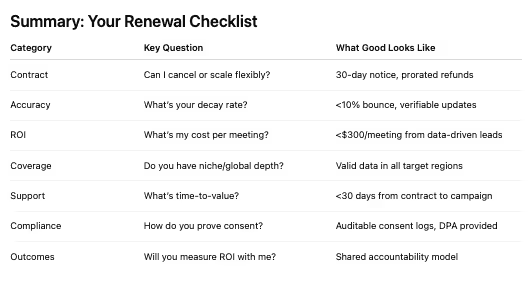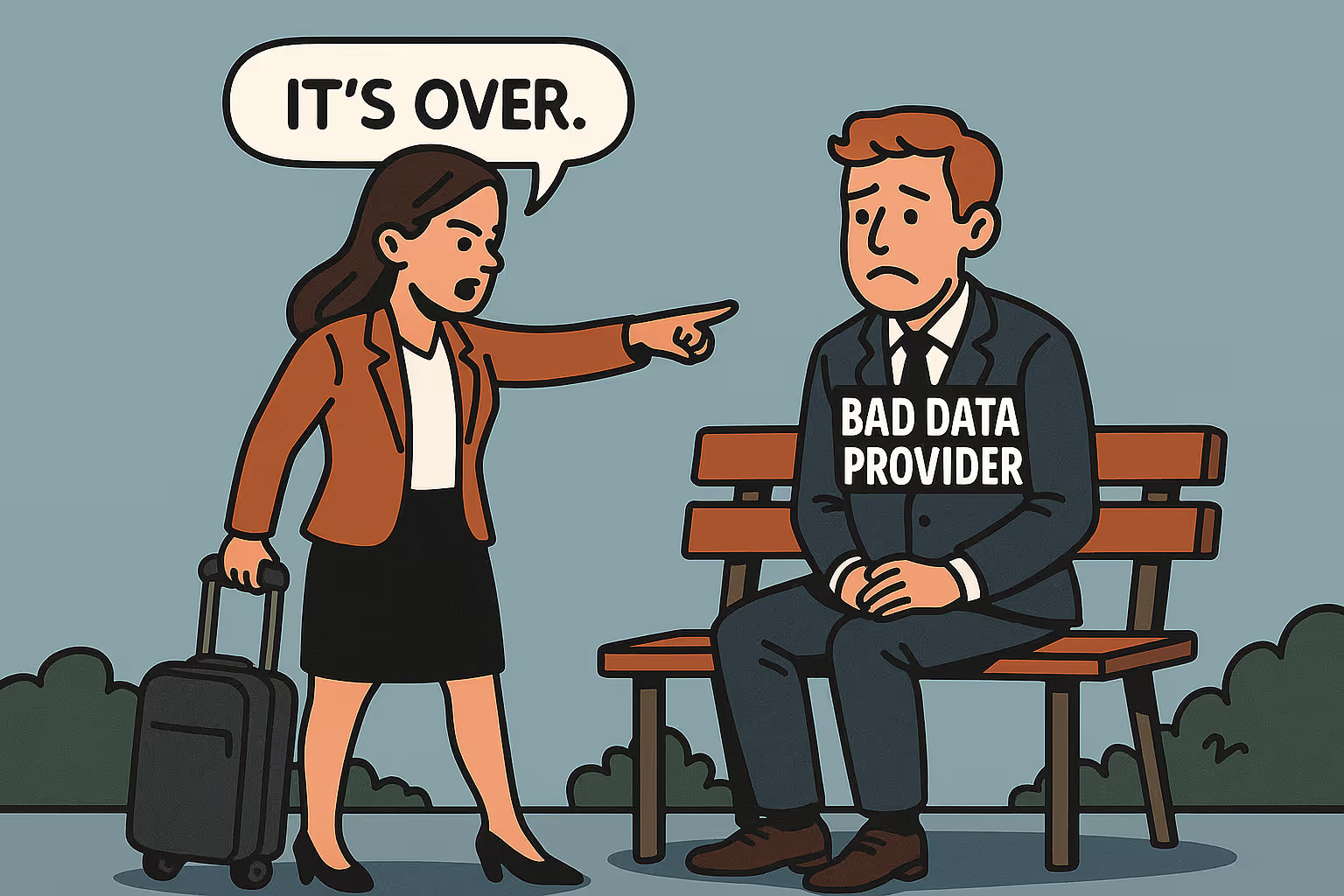It’s renewal season — and across the GTM world, leaders are quietly signing six-figure renewals with data vendors they haven’t audited in a year. ZoomInfo, Apollo, Cognism — they’ve become so embedded in the tech stack that most teams treat them as utilities rather than investments. But that complacency is costing you.
Every RevOps leader who’s ever struggled with a 20% bounce rate, duplicate records, or “intent signals” that never convert knows the truth: bad data doesn’t just waste budget — it corrupts strategy. It inflates your TAM, misguides your pipeline, and blinds your campaigns to the signals that actually matter.
Before you renew another annual contract, it’s worth asking whether your provider is still an asset — or if it’s quietly become a liability. The list below outlines the seven areas every GTM team should audit before signing anything: contract flexibility, data accuracy, cost transparency, coverage depth, integration speed, compliance posture, and outcome accountability.
Because in today’s market, data isn’t just about coverage — it’s about confidence.
And if your vendor can’t prove accuracy, ROI, and compliance lineage, you’re not managing a data partnership… you’re managing risk.
1. Contract & Renewal Terms
Objective: Protect budget flexibility and avoid hidden liabilities.
Ask:
- What is your exact cancellation notice requirement — and do I receive an official reminder?
- If usage is low or performance poor, is there a pro-rata refund or contract rollback clause?
- Can I add or remove licenses quarterly without resetting the full annual term?
- What’s the renewal mechanism — auto-renew, or manual review?
Red Flags:
- “Silent” renewals buried in fine print.
- Vendors requiring written notice 60–90 days prior.
- Price escalation at renewal with no corresponding data performance review.
What to be open to:
Running a data ROI audit before renewal. Ask for a vendor-run performance review tied to delivered pipeline outcomes, not vanity usage stats.
2. Data Accuracy, Decay, and Utility
Objective: Understand how much of your current data is actually usable.
Ask:
- What’s your verified accuracy rate by region, segment, and channel (email, phone, LinkedIn)?
- What’s your bounce rate and no-connect rate for EMEA, LATAM, and APAC?
- How frequently do you refresh company hierarchies, job changes, and signals?
- Can you provide a list of contacts or accounts that have decayed or gone invalid this year?
Red Flags:
- “We don’t guarantee accuracy for niche segments.”
- Vendor refuses to disclose refresh cadence.
- No transparency into decay rates or update logic.
What to be open to:
Supplementing static data with on-demand enrichment from a vendor like LeadGenius — where every contact is verified in real time and custom-built for your ICP.
3. Pricing, Cost Escalation, and ROI Transparency
Objective: Measure true cost per outcome, not per contact.
Ask:
- What is my effective cost per qualified meeting or pipeline dollar created using your data?
- Can you break down costs by license, add-ons, and wasted data?
- What is my total contact utility rate — i.e., % of purchased contacts that convert into a meaningful sales touch?
- How many of my contacts were duplicates, expired, or unreachable?
Red Flags:
- Vendors quote by “credits” without outcome visibility.
- No mechanism to connect data spend to CRM or campaign ROI.
What to be open to:
- Exploring transparent, per-record pricing models (like LeadGenius’s new model) that show cost per campaign and allow ROI-level visibility.
- Testing small-batch, campaign-based data pilots to benchmark effectiveness.
4. Global & Niche Market Coverage
Objective: Evaluate whether your provider actually covers your total addressable and reachable market.
Ask:
- What is your coverage by region and vertical for our ICP (especially if global or specialized)?
- Do you support long-tail technographics, supply chain, or e-commerce data?
- How strong is your coverage in non-English markets or specific verticals (e.g. MedTech, FinServ, Manufacturing)?
- Can you provide sample data for niche industries?
Red Flags:
- Vendor admits poor coverage outside the U.S.
- They upsell “Global” data as a premium add-on.
What to be open to:
Partnering with a bespoke data vendor who can build your global or niche audience to spec instead of leasing from a U.S.-centric static lake.
5. Integration, Support & Time-to-Value
Objective: Quantify the real operational cost of using the platform.
Ask:
- How long does it take from setup to usable data (first campaign, first sync)?
- What SLAs exist for support, refreshes, and bug fixes?
- How do you handle enrichment failures or API downtime?
- Can I automate enrichment directly within Salesforce, HubSpot, or Marketo — or do I need manual exports?
Red Flags:
- Vague or non-measurable SLAs.
- Reactive (not proactive) support responses.
What to be open to:
- Shifting to managed data delivery — where data arrives pre-mapped to your CRM, deduped, and campaign-ready.
- Prioritizing time-to-value metrics over flashy UI or bundled features.
6. Compliance & Risk
Objective: Avoid future privacy exposure, fines, or brand damage.
Ask:
- Can you provide full GDPR/CCPA/LGPD documentation?
- What’s your consent provenance model — how is data permissioned, tracked, and auditable?
- How do you handle data deletion and suppression requests?
- Is your data opt-in, inferred, or publicly scraped?
Red Flags:
- Vendor relies on “publicly available” loopholes.
- No clear DPA, data lineage documentation, or compliance audit.
What to be open to:
- Moving toward opt-in, consent-safe contact activation (like LeadGenius’s Global Activation Data).
- Consolidating compliance and activation workflows under one data partner that indemnifies your outreach.
7. Outcome-Based Accountability
Objective: Align vendor performance with revenue impact.
Ask:
- Will you tie renewal pricing to usage and ROI metrics, not flat license fees?
- Can you establish a data performance SLA (accuracy %, bounce %, contact reach rate)?
- What proof do you have that this data actually drives meetings or revenue?
Red Flags:
- “We can’t measure that.”
- “That depends on your sales team’s performance.”
What to be open to:
- Outcome-based pricing or shared-risk contracts tied to meetings, conversions, or verified pipeline contribution.
- Running a parallel pilot with a performance-driven vendor to benchmark outcomes before locking in renewal.

Bottom Line
If your data vendor can’t quantify accuracy, cost-per-outcome, or compliance provenance, you’re not managing a data partnership — you’re managing risk.
Before you renew, benchmark your spend against:
- Outcome metrics: meetings, opportunities, pipeline.
- Usability rate: % of data still valid and reachable.
- Cost-per-outcome: total spend ÷ actual revenue influence.
And finally — be open to the idea that the best data isn’t “all-in-one.”
It’s all about you — your ICP, your regions, your campaigns, and your motion.
That’s what bespoke data means.




